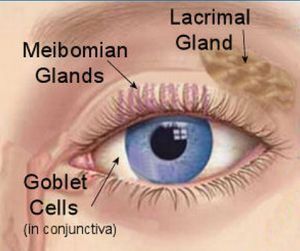Dry Eyes
Dry Eye Disease
Dry Eye Disease (DED) is an inflammatory condition in which either the tear film evaporates too quickly, or tear production is too low, or both. The result is irritation, blurred vision, grittiness, burning, pain, corneal ulcers, redness, photosensitivity, and infections. Although up to 30% of Canadians suffer from dry eyes, over 90% of people living with Sjögren’s deal with the most severe form of DED.
The tear film is made up of three main components: The watery portion of the tears comes from the lacrimal glands and contains lubricants and special proteins that fight off infection and maintain the health of the surface cells. The mucous portion produced by goblet cells in the conjunctiva, thickens the tear film and helps maintain a slippery surface so that the lids can move over the surface easily. The oils from the meibomian glands which are released during every blink, sit on the surface of the tear film to prevent evaporation. In Sjögren’s, inflammation of tear and oil secreting glands cause the tear film to fail and become compromised and unstable.
Meibomian Gland Dysfunction (MGD) occurs when the small meibomian glands behind our eyelashes produce inadequate or poor-quality oils which results in tears evaporating too quickly.

Monitoring Dry Eye Disease
It is essential that individuals with Sjögren’s see an optometrist and/or ophthalmologist on a regular basis. These eye-care specialists are trained to perform diagnostic tests to assess tear production, tear stability, tear distribution and overall health of the eyes. An optometrist can perform many tests and treatments for DED and will refer patients to an ophthalmologist if surgery or more complex treatment is required.
Dry Eye Treatments
Here are some of the treatment options recommended and provided by eye care professionals for DED:
- Prescribing anti-inflammatory drops and therapy
- Inserting punctal plugs in lower and/or upper tear ducts
- Permanently cauterizing the tear ducts
- Autologous serum drops
- Meibomian gland therapies
- Scleral contact lenses
Self-Care of Dry Eyes
There are many treatment recommendations that people with Sjögren’s should consider for relief of dry eye symptoms as part of their daily self-care regimen at home or work:
- Artificial Tears: Regular and proactive use of moisturizing preservative-free eye drops throughout the day is the foundation of dry eye treatments particularly when you are doing visual tasks. Your doctor can make a recommendation to help you select the best drops for your DED.
- Omega-3 Supplements: Taking 2000 mg of Omega-3 supplements help the meibomian glands in the eyelids to produce better quality oils to stabilize the tear film.
- Eyelid Hygiene: The goal of eyelid hygiene is to improve the flow of oil, prevent clogged glands and remove dead skin and debris. Scrub the eye lashes using a gentle soap and warm wet washcloth or eyelid cleansing wipes.
- Warm Compresses and Massage: A warm compress is a mask filled with small beads or gel and placed on the eyes to release more oils from the meibomian glands. The mask is heated in the microwave for about 20 seconds and then applied to the eyes until the mask is no longer warm. Avoid burning your skin. Massaging the eyes after the compress may also help increase the oil release.
- Humidifier: Using a humidifier is very important for Dry Eye Disease especially during the wintertime when the air is very dry. Keep the humidity between 40 to 45% in your home, at work, and when travelling.
- Overnight Eye Care: To allow for maximum healing of dry eyes overnight, use gels, ointments, a humidifier, and an eye mask which provides a moisture seal.


